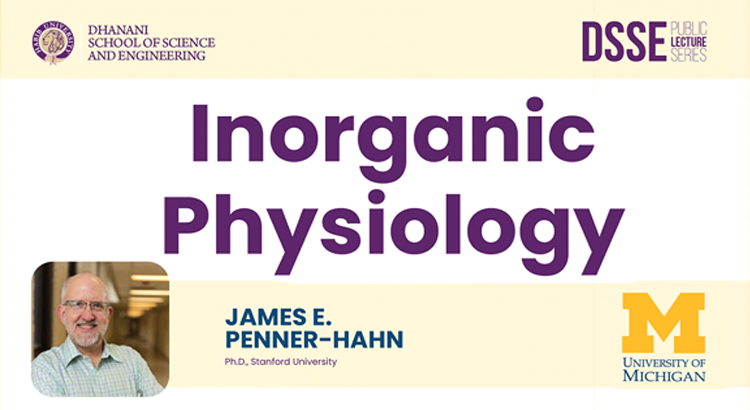27th November, 2019
James Penner-Hahn is the George A. Lindsay Collegiate Professor of Chemistry and Biophysics at the University of Michigan, where he is also senior advisor to the Dean for International Partnerships. He acquired his doctoral degree from Stanford in 1984 with a PhD dissertation titled, X-ray Absorption Studies of Metalloprotein Structure: Cytochrome P-450, Horseradish Peroxidase, Plastocyanin, and Laccase. He was elected as a Fellow of the American Association for the Advancement of Science in 2004. His interests lie in areas of biophysical chemistry and inorganic spectroscopy including EXAFS and synchrotron radiation techniques which he helped to develop in his doctoral and post-doctoral work. Dr. Penner was elected as a Fellow of the American Association for the Advancement of Science in 2004.
Dr. Penner introduced his research by delving into an explanation of inorganic physiology. Metals present as trace elements within cells and their behaviour in various environments is what the speaker hoped to direct attention towards. Studying cells at the inorganic elemental level can allow identification of essential biological systems and discovery of effective ways to address dangers like parasitic infections and cadmium toxicity. Dr. Penner wished to emphasise the importance of understanding that metal ions within cells exist in highly complicated systems and interact in complex ways, hugely impacting cell functioning. To illustrate the specialised behaviour of metal trace elements, he depicted how a yeast cell and the cell of a chicken egg share the same metal concentrations. The speaker found it fascinating that within two entirely different organisms and their individual biological environments, the cells can exhibit same characteristics, homeostasis being an important one.
The Fura-2 molecule engineered by Nobel Prize winner, Roger Tsein is one tool used to measure metal concentrations in cells. According to Dr. Penner, the use of x-ray fluorescence spectroscopy that his research incorporated, proved successful in being able to detect a greater variety of trace elements, among which are metals more crucial to their investigation of inorganic systems. Spectroscopy enabled the measurement of trace elements such as potassium and phosphorous, while Fura-2 would gave best results for zinc and calcium.
The speaker shared two cases in which close observation of metal ions led to intriguing findings in the cellular structure. It appeared that in the instance of malarial infection, when the plasmodium invades the red blood cell it feeds off on iron present in hemoglobin. What is interesting is that at the same time the parasite has to get rid of excessive iron in the cell. The increasing concentration of zinc within infected cells as seen through x-ray spectroscopy shows that the parasite is pumping in more zinc, this information is supported by existing research. Further, it was learnt that even though inhibitors like EDTA reduce zinc concentration, the parasite still persists by increasing its iron consumption. The results make it clear that inhibiting zinc alone is not a completely effective solution. Advanced knowledge of inorganic physiology that makes us aware of how infections take effect within cells can help us find more precise ways of countering them, as in this instance it may be by preventing the zinc regulatory process of malaria.
The other case studied by Dr. Penner was that of cadmium toxicity. Cadmium is likely to enter the body through tobacco ingestion as it is found to contaminate tobacco plant fertilizer. For this investigation, light microscopy and fluorescence microscopy was used. It was evident in the results that with cadmium occurrence, the homeostasis was disturbed, concentrations of all elements, iron, potassium, zinc and copper were all impacted, causing toxicity. Dr. Penner pointed out that it was not just metal concentration that was of value but also its distribution. Dr. Penner depicted the changing concentration and distribution spread through the use of elaborate figures, where he identified the lit up areas of a cell as having high concentration. The altered level of copper in the presence of cadmium was most notable as it occurred in unusual places and in high concentrations, going on to suggest that it is in combination with copper that cadmium has toxic effects.
Conventionally, physical chemists like Dr. Penner himself hold deterministic views regarding cell behaviour. However, his research has proven that there is much more to its structure and mechanism as metal ions within it interact in intricate ways. He informed that in reality the cells have a zinc dependent model, where zinc levels are adjusted according to need, while iron concentration remains largely constant. It is also known that metal structures can be altered under the influence of other elements as in the case of Fura-2 molecule transforming calcium ions. This highly speciallised biological system, maintaining homeostasis and changing under different conditions, is a physiological phenomenon that holds many more complex processes to be understood and has high potential for fresh solutions. With questions of cell mutation and carcinogenic activity coming up, the expanding field of inorganic physiology gains greater significance.

